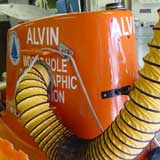

Nikkei Ecology column, written October 2003
The Climate Watchers
Risks come in many forms. The bullets that recently whizzed past the research vessel Maurice Ewing off the coast of Somalia, and the rocket-propelled grenade that skipped across the Red Sea towards the ship, were examples of the growing threat of marine terrorism and piracy. In 2001 alone, 335 incidents of piracy - including 16 hijackings - were recorded by the International Maritime Bureau's Piracy Reporting Centre. At least 21 crewmembers were killed and 210 were held hostage. On this occasion, happily, the ship escaped - and continued with its environmental research mission.
I came across this story when I visited the Woods Hole Oceanographic Institution (WHOI) in September. Based in the United States, on the east coast's beautiful Cape Cod peninsula, WHOI is a Mecca for oceanographic researchers. In fact, I had wanted to visit for over thirty years when I met WHOI President Dr Bob Gagosian at the 2003 World Economic Forum meeting. My main reason for wanting to visit was to get a better sense of WHOI's work on climate change.
Whether SustainAbility is working for energy companies like Shell, auto-makers like Ford and Toyota, or re-insurance groups like Swiss Re, the issue of climate change is now surfacing constantly. And the worrying thing about WHOI's research is that it is showing growing evidence that shifts in our climate are often abrupt, happening much faster than we might imagine.
Invited to visit by Dr Gagosian, I found myself unexpectedly standing on the tiny deck of the submersible Alvin, which helped rescue a lost hydrogen bomb off the coast in the 1960s and also dived down to the wrecks of ships like the Titanic. But deeply fascinating though this was, the work on climate change described by Dr Dave Gallo, WHOI Director of Special Projects, was even more interesting. And the implications for our future are profound.
Much of the work uses high technology like space satellites, but some involves more basic skills. One area that WHOI scientists have been looking at is the climate record stored in ancient corals. "Corals look like rocks," said Anne Cohen, one of the scientists involved. "They don't move and they are silent. But they are continuously growing, all the while acting as tape recorders of information we need to track variations in climate." Corals, as Cohen put it, "are natural climate recorders. They grow continuously, so there are no gaps in the record. And they grow for a long time, sometimes reaching 1,000 years old."
Using such evidence, scientists can build a much better understanding of the number and scale of hurricanes in the deep past. And that's something the insurance and re-insurance industries desperately need to understand these days, as their losses from hurricanes and other natural disasters escalate.
One issue the researchers have been investigating recently is the North Atlantic Oscillation (NAO), a phenomenon in which the Atlantic ocean and the atmosphere develop an unusual set of feedback mechanisms. When things go well, the 'positive' phase, the eastern United States and northern Europe enjoy warmer weather. When the system switches to the 'negative' phase, however, winters become more severe and storms follow different tracks. Interestingly, the evidence suggests that since the 1970s the system has been stuck in a 'positive' phase more intense than any on record. The obvious question: Has the climate crossed some new threshold, perhaps triggered by climate change?
Even though the first report I wrote on climate change appeared as long ago as 1978, and I imagined I was fairly well informed, I left WHOI feeling more concerned - and determined to keep a weather eye on WHOI's work via its very useful website www.whoi.edu.